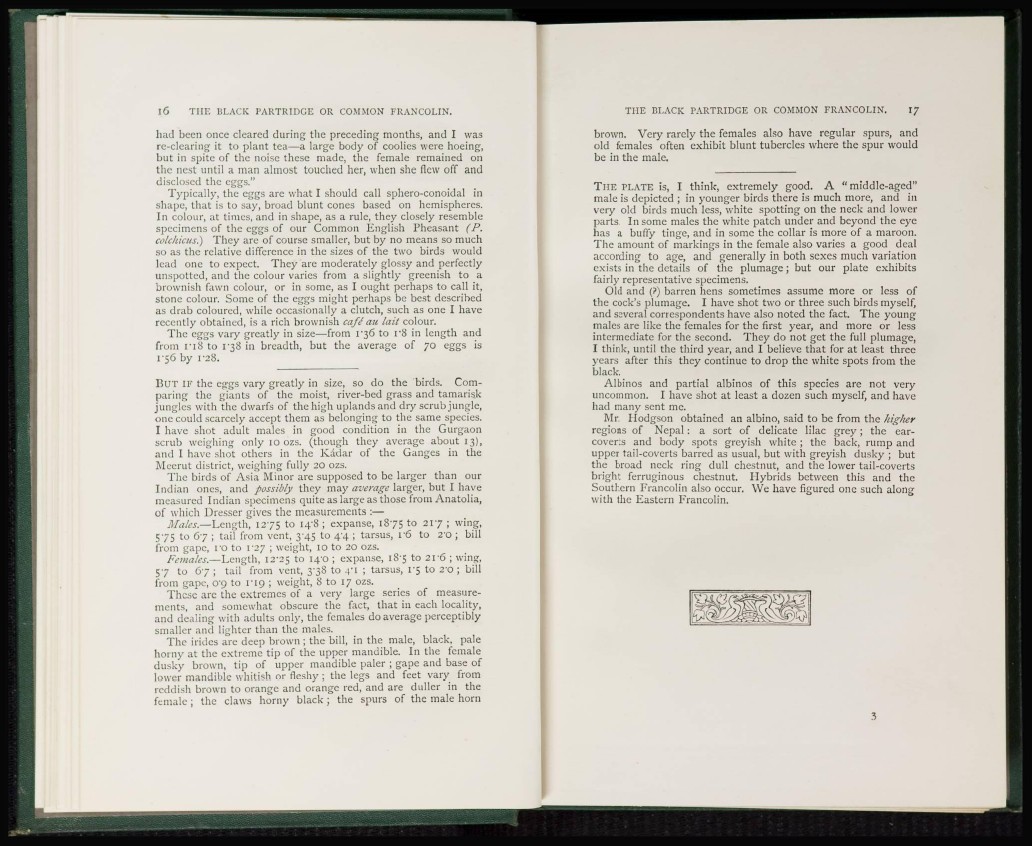
B U T I F the eggs vary greatly in size, so do the birds. Comparing
the giants of the moist, river-bed grass and tamarisk
jungles with the dwarfs of the high uplands and dry scrub jungle,
one could scarcely accept them as belonging to the same species.
I have shot adult males in good condition in the Gurgaon
scrub weighing only 10 ozs. (though they average about 13),
and I have shot others in the Kadar of the Ganges in the
Meerut district, weighing fully 20 ozs.
The birds of Asia Minor are supposed to be larger than our
Indian ones, and possibly they may average larger, but I have
measured Indian specimens quite as large as those from Anatolia,
of which Dresser gives the measurements :—
Males.—Length, 1275 to izt/8 ; expanse, 1875 to 2 1 7 ; wing,
575 to 6 7 ; tail from vent, 345 to 4^4 ; tarsus, 16 to 2'0 ; bill
from gape, r o to r27 ; weight, 10 to 20 ozs.
Females.—Length, 12^25 to 14x1 ; expanse, iS'5 to 2 1 6 ; wing,
57 to 67 ; tail from vent, 3-38 to 4 ' ! ; tarsus, 1-5 to 2'0 ; bill
from gape, O'g to r i g ; weight, 8 to 17 ozs.
These are the extremes of a very large series of measurements,
and somewhat obscure the fact, that in each locality,
and dealing with adults only, the females do average perceptibly
smaller and lighter than the males.
The irides are deep brown ; the bill, in the male, black, pale
horny at the extreme tip of the upper mandible. In the female
dusky brown, tip of upper mandible paler ; gape and base of
lower mandible whitish or fleshy ; the legs and feet vary from
reddish brown to orange and orange red, and are duller in the
female ; the claws horny black ; the spurs of the male horn
brown. Very rarely the females also have regular spurs, and
old females often exhibit blunt tubercles where the spur would
be in the male.
T H E PLATE is, I think, extremely good. A "middle-aged"
male is depicted ; in younger birds there is much more, and in
very old birds much less, white spotting on the neck and lower
parts. In some males the white patch under and beyond the eye
has a buffy tinge, and in some the collar is more of a maroon.
The amount of markings in the female also varies a good deal
according to age, and generally in both sexes much variation
exists in the details of the plumage; but our plate exhibits
fairly representative specimens.
Old and (?) barren hens sometimes assume more or less of
the cock's plumage. I have shot two or three such birds myself,
and several correspondents have also noted the fact. The young
males are like the females for the first year, and more or less
intermediate for the second. They do not get the full plumage,
I think, until the third year, and I believe that for at least three
years after this they continue to drop the white spots from the
black.
Albinos and partial albinos of this species are not very
uncommon. I have shot at least a dozen such myself, and have
had many sent me.
Mr. Hodgson obtained an albino, said to be from the higher
regions of Nepal: a sort of delicate lilac grey; the earcoverts
and body spots greyish white ; the back, rump and
upper tail-coverts barred as usual, but with greyish dusky ; but
the broad neck ring dull chestnut, and the lower tail-coverts
bright ferruginous chestnut. Hybrids between this and the
Southern Francolin also occur. We have figured one such along
with the Eastern Francolin.
liad been once cleared during the preceding months, and I was
re-clearing it to plant tea—a large body of coolies were hoeing,
but in spite of the noise these made, the female remained on
the nest until a man almost touched her, when she flew off and
disclosed the eggs."
Typically, the eggs are what I should call sphero-conoidal in
shape, that is to say, broad blunt cones based on hemispheres.
In colour, at times, and in shape, as a rule, they closely resemble
specimens of the eggs of our Common English Pheasant (P.
colcliicus.) They are of course smaller, but by no means so much
so as the relative difference in the sizes of the two birds would
lead one to expect. They are moderately glossy and perfectly
unspotted, and the colour varies from a slightly greenish to a
brownish fawn colour, or in some, as I ought perhaps to call it,
stone colour. Some of the eggs might perhaps be best described
as drab coloured, while occasionally a clutch, such as one I have
recently obtained, is a rich brownish café au lait colour.
The eggs vary greatly in size—from I'36 to r8 in length and
from I ' l l to 1-38 in breadth, but the average of 70 eggs is
1-56 by T28.